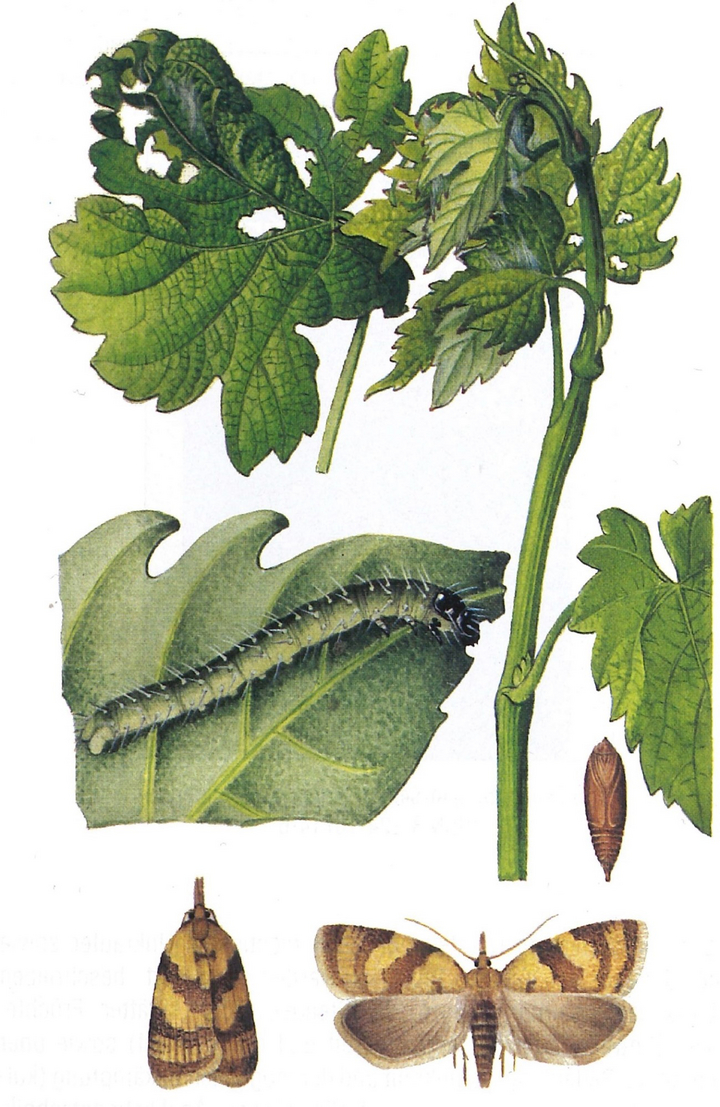Grapevine leaf roller
Sparganothis pilleriana
Appearance

The jumping worm moth is an 11 to 15 mm large butterfly with a wingspan of 20 to 25 mm. The wings are brownish-yellow with two to three brown-reddish cross bands and a spot at the base of the wing.
The eggs are scale-like, greenish-yellowish in colour and are laid in overlapping groups.
The caterpillars are 20-30 mm long and grey-green in colour with a dark brown head capsule.
The pupae are approx. 12 mm long and brownish in colour.
Biology
The spring worm moth produces one generation per year, does not require much warmth and is also found in northern wine-growing areas.
The young caterpillars of the spring worm moth overwinter under the bark of the vine or in crevices of the vine stems in a cocoon. From the beginning of April to the beginning of May, they leave their hibernation hiding places and attack the buds. After developing and feeding on leaves and shoots for about 40 to 55 days, the caterpillars pupate in convoluted leaf nests. After a pupal dormancy of two to three weeks, the moths hatch, and their flight period extends from early July to late August.
The springworm moth lays several clutches of about 40-60 eggs, on the upper surface of vine leaves.
After about two weeks, the young caterpillars hatch from the eggs (from mid/late July to early September) and seek out overwintering quarters.
Damage symptoms
The caterpillars bore into the buds at the time of budding and hollow them out, causing feeding damage to leaves, shoots and shoots after budding. The leaves and other infested plant parts are spun together. When these leaf nests open, the caterpillars retreat by leaps and bounds ("jumping worm") and quickly descend to the ground on a thread of secretion. The eaten leaves and shoot tips can dry out and die. The feeding damage can lead to defoliation.
The feeding damage and the formation of webs on the shoots could be confused with infestation by the much smaller caterpillars of the first generation of the grape berry moth ("hayworm").
Host plants
The jumping worm moth is considered to be extremely polyphagous. Its host plant spectrum includes more than 100 plant species and, in addition to grapevines(Vitis spp.), also strawberries, blackberries, chestnuts, Prunus species, quince, black elderberries and various composite plants and legumes.
Prevention and control
- Various predatory insects, e.g. ladybirds, lacewings, earwigs as well as parasitic parasitic wasps and parasitic caterpillar flies are considered natural antagonists (protect beneficial organisms!).
- Checks for egg-laying by the jumping worm moth in summer can serve as a decision-making aid for possible budding treatments in the following spring.
- The damage threshold for chemical plant protection measures is five to ten caterpillars per vine at the three- to five-leaf stage.
- Only bud burst treatments at the time of bud swelling (BBCH stage 01 - 11) or spring treatments from the three-leaf stage (BBCH 13 to BBCH 19) are considered sensible as plant protection measures - see the list of plant protection products authorised in Austria.
Last updated: 16.12.2025
automatically translated